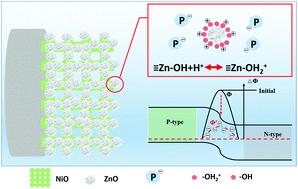Our official English website, www.x-mol.net, welcomes your feedback! (Note: you will need to create a separate account there.)
Using the interfacial barrier effects of p-n junction on electrochemistry for detection of phosphate.
Analyst ( IF 4.2 ) Pub Date : 2020-03-25 , DOI: 10.1039/c9an02579k Yu Ding 1 , Minggang Zhao , Jiatuo Yu , Xiaomin Zhang , Zhengming Li , Hui Li
Analyst ( IF 4.2 ) Pub Date : 2020-03-25 , DOI: 10.1039/c9an02579k Yu Ding 1 , Minggang Zhao , Jiatuo Yu , Xiaomin Zhang , Zhengming Li , Hui Li
Affiliation

|
A novel type of electrochemical sensor for detection of phosphate in water environment was developed by combining the interfacial barrier of p-n junction with the adsorption of phosphate. The electrochemical response was produced by the induced change of the barrier height, which was only caused by the specific adsorption of phosphate. Two linear concentration ranges (0-0.045 mg L-1 and 0.045-0.090 mg L-1) with two sensitivities (4.98 μA (μg L-1)-1 and 1.28 μA (μg L-1)-1) were found. The good performance made the sensor meet the requirements of the World Health Organization for drinking water (1 mg L-1 of phosphate). It is an approach to develop electrochemical sensors by employing the interfacial barrier effects on electrochemistry.
中文翻译:

利用pn结对电化学的界面势垒效应检测磷酸盐。
通过结合pn结的界面势垒和磷酸盐的吸附,开发了一种新型的水环境中磷酸盐检测的电化学传感器。电化学反应是由势垒高度的诱导变化产生的,这仅是由磷酸盐的特定吸附引起的。发现了两个线性浓度范围(0-0.045 mg L-1和0.045-0.090 mg L-1),并具有两个灵敏度(4.98μA(μgL-1)-1和1.28μA(μgL-1)-1)。良好的性能使该传感器符合世界卫生组织对饮用水(1 mg L-1磷酸盐)的要求。通过利用对电化学的界面势垒效应来开发电化学传感器是一种方法。
更新日期:2020-03-16
中文翻译:

利用pn结对电化学的界面势垒效应检测磷酸盐。
通过结合pn结的界面势垒和磷酸盐的吸附,开发了一种新型的水环境中磷酸盐检测的电化学传感器。电化学反应是由势垒高度的诱导变化产生的,这仅是由磷酸盐的特定吸附引起的。发现了两个线性浓度范围(0-0.045 mg L-1和0.045-0.090 mg L-1),并具有两个灵敏度(4.98μA(μgL-1)-1和1.28μA(μgL-1)-1)。良好的性能使该传感器符合世界卫生组织对饮用水(1 mg L-1磷酸盐)的要求。通过利用对电化学的界面势垒效应来开发电化学传感器是一种方法。



























 京公网安备 11010802027423号
京公网安备 11010802027423号